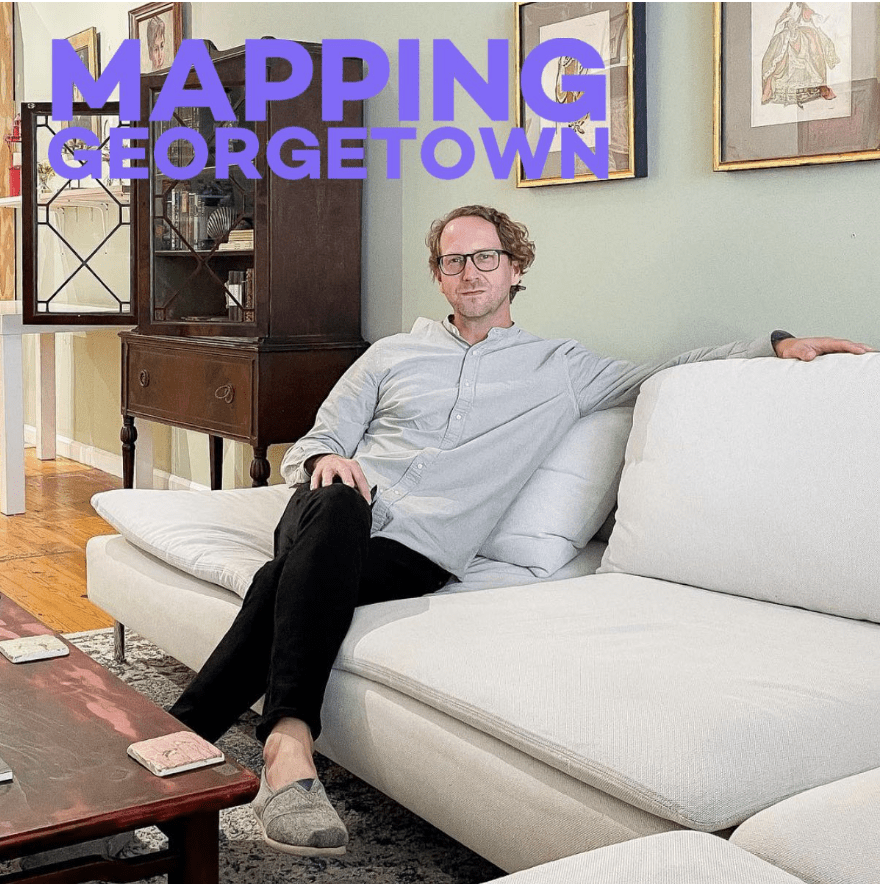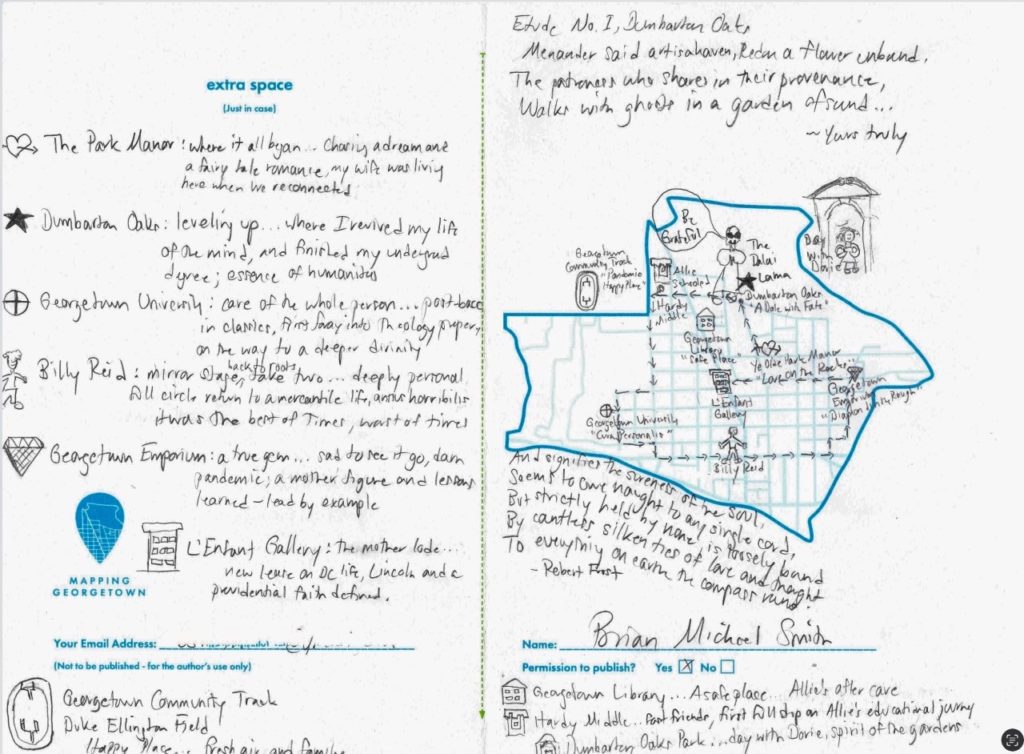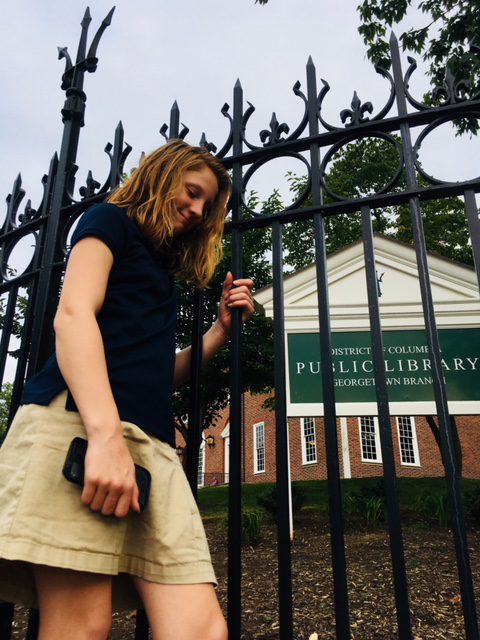Mapping Georgetown: Thankfulness for Family, Georgetown and the Dalai Lama
By • December 5, 2022 0 1157

At Mapping Georgetown, we continue to celebrate our gratitude during this special season of thankfulness.
Today’s feature is from Georgetowner Brian Michael Smith whose story is a special meditation on thankfulness for our community and neighborhood as well as family, cherished memories… and the Dalai Lama.
Currently based at L’Enfant Gallery in Georgetown, Brian is a writer, gallerist, and educator with an abiding love of art, ideas, and good conversation.
“The spirit of Georgetown is alive and well, its natural beauty and cultural blessings diverse and inestimable indeed,” Brian writes, in a story that reads like his personality. “And any opportunity to express our gratitude for the people and places we love and make us who we are is a gift. This exercise has brought up emotions long dormant and recalled memories I will cherish forever. And for that, you guessed it, I am grateful.”
Brian Smith’s Story-Map

The Park Manor: where it all began… chasing a dream and a fairy tale romance, my wife was living here when we reconnected
Dumbarton Oaks: leveling up… where I revived my life of the mind, and finished my undergrad degree; essence of humanitas
Georgetown University: cura personalis… care of the whole person, post-baccalaureate in classics, first foray into theology proper, on the way to a deeper divinity
Billy Reid: mirror stage… back to roots take two, deeply personal return to a mercantile life; annus horribilis, it was the best of times, the worst of times
Georgetown Emporium: a true gem… sad to see it go, darn pandemic; a mother figure and lessons learned — lead by example
L’Enfant Gallery: the mother lode… new lease on DC life, communing with Lincoln and a providential faith defined
Georgetown Library: a safe place… Allie’s after care
Hardy Middle: fast friends… first full stop on Allie’s educational journey
Dumbarton Oaks Park: a day with Dorie, spirit of the gardens
Etude No. 1 (the start of a poem, by yours truly)
Menander said art is a haven, Redon a flower unbound–
the patroness who shares in their provenance,
walks with ghosts in a garden of sound…
–Brian Smith
And signifies the sureness of the soul,
Seems to owe naught to any single cord,
but strictly held by non is loosely bound
By countless silken ties of love and thought
To everything on earth the compass round
–Robert Frost
—
Brian is launching a new concept, Four Quarters Art and Books, in a month-long holiday pop-up downtown in Mount Vernon Square. Four Quarters is an art gallery, book store, and public forum offering curated collections of local and globally recognized artists, antiques and vintage gifts, classic works of literature and scholarship, and an independent space for civil discourse around issues of urgent and enduring concern.
1015 1/2 7th Street NW
December 1-30.
Food For Thought, from Brian Smith
I love Georgetown. The charm, the beauty, the history, the lore — the spirit of the place — has been a source of inspiration since I moved here over a decade ago. Although I no longer live in the neighborhood, I still consider it home.
From the day I walked up the hill from ye olde Park Manor and got a job at Dumbarton Oaks, to my current coordinates at L’Enfant Gallery, I have found in Georgetown so many wonderful and unique opportunities to map out a meaningful life, and I am grateful for it.
In this spirit of Thanksgiving, I must thank Marilyn Butler at Mapping Georgetown for inviting me to share a couple points of personal interest on that map, and also to the Cultural Leadership Breakfast at the Tabard Inn, a place dear to my heart. Even more fortuitous was that the speaker happened to be my former boss, Yota Batsaki, executive director at Dumbarton Oaks.
Dumbarton Oaks is one of the most beautiful and learned museums and research centers in the world. It will always be marked with a star on the map of my life. At a crucial juncture, through a twist of fate, it became a site of refuge, rediscovery, and renaissance, a true alma mater, and the best of all possible environments in which to reconnect with my intellectual roots and map a new course for the future.
The director spoke eloquently about the vision inherited from the founders, Mildred and Robert Bliss, and the guiding principles at the root of the institution, right down to the very “DNA” of Dumbarton: diplomacy, research, education, collecting, and philanthropy. I have told her in the past how much the experience formed me, but seeing this genetic code of core values mapped out, and how it guides my work today, shows just how ingrained they are.
So I must also say in print how grateful I am to Yota for her leadership, to Dumbarton Oaks itself and all the wonderful people I met there, and to Harvard for my degree at the extension school. It truly is a “home for the humanities,” a crown jewel of Georgetown, a humane institution at the heart of American history, and my own.
And sitting there in the Tabard listening to the director’s remarks, I found myself traveling back to those halcyon days, nodding along as she described the challenges of synthesizing a vision and articulating a clear self-identity at an institution with such diverse collections and constituents. I’m thinking, how like my own life at the time, and life in general? Pulled in so many directions, so many interests, so much you want to do and become. What ties it all together?
And looking around the room, hearing about the founders’ concern to harmonize the Old World with the New, I was also thinking how easily these questions can be mapped onto American life and history, especially the story of the Pilgrims and Thanksgiving. Sitting down with strangers around a common table, grateful for good food and new friends, mapping out the future, it occurred to me just how much of that history boils down to this core civil and cultural challenge of integrating diverse peoples and reconciling competing interests.
Whatever the myths and legends, given the conditions leading up to the “first” Thanksgiving, I think the Pilgrims were sincere in their gratitude, keeping the peace and giving thanks with their neighbors for nearly half a century. While Thanksgiving may have become a caricature, and it may have been exceptional, the peace treaty between the Pilgrims and Wampanoags was an early testament to effective cultural leadership, and remains a lesson for us today.
Speaking of leadership, and lessons learned, and peace, and giving thanks, thinking about all this reminded me of the time I got schooled by the Dalai Lama. It was one of the most interesting encounters with a public figure at Dumbarton Oaks, though I didn’t actually meet him!
What happened was that the Dalai Lama and his entourage showed up to the gardens unannounced. The security guard on duty, one of the nicest guys you’d ever meet, greeted him and went about his business. Before leaving, as a gift of his gratitude, the Dalai Lama gave the guard a bag of almonds, and blessed them.
How amazing and wonderful, right? Upon hearing the story, I was almost out the door to go looking for him when the guard then proceeded to tell me, to my utter disbelief, that the very incarnation of thanksgiving, the living Buddha, was already gone! The guard had initially told no one he was there. At least, he didn’t tell me. And what is more, he ate every last one of the blessed almonds, again, sharing nary a nut with me. I couldn’t believe it. Frankly, I was fuming.
As much wisdom and patience as I had gained by that point in my life, I was (and can still be) a little hot-headed. The reality however was self-evident: I was not entitled to an audience with the Dalai Lama. It didn’t matter that I was studying his ideas at the time, that the serendipity couldn’t have been more real. That it could have been the opportunity of a lifetime.
The lesson was simple: don’t be selfish. It was also, of course, be grateful. Let it be known then that I am grateful to Garfield Tyson, may he rest in peace, who kept us all safe that day, and the Dalai Lama for the life lesson. Incidentally, this is not too far off from the lesson in humility proclaimed by Abraham Lincoln to officially establish Thanksgiving as a federal holiday.
Like in previous iterations of the practice, the nation, and all wayward souls, are called to repent: “to offer up penitent and fervent prayers and supplications to the Great Disposer of Events for a return of the inestimable blessings of peace, union, and harmony throughout the land.” Not quite sure who the Great Disposer is, but I’ve been to a few of their events. A real humbled down to the dust experience, not to be missed.
Truth be told, with everything going on right now, it’s not a terrible idea. Maybe it’s what makes the holiday, well, holy. Or maybe it’s the beauty and abundance of nature? There is one last thing about Dumbarton Oaks that came up, and perhaps the most obvious. That is, the trees, and how much the founders valued the natural landscape as integral to the spirit of a place, and the cultivation of a deeper humanity.
The spirit of Georgetown is alive and well, its natural beauty and cultural blessings diverse and inestimable indeed. And any opportunity to express our gratitude for the people and places that we love and make us who we are is a gift. This exercise has brought up emotions long dormant and recalled memories that I will cherish forever. And for that, you guessed it, I am grateful.
—
The story would not be complete without a peek at Brian’s best work, the loves of his life, daughters Allie and Dorothea.

Daughter Dorothea. Photo taken in Dumbarton Oaks Park, in front of the Forsythia Gate. Photo courtesy of Brian Smith.

Daughter Allie, taken in front of Georgetown Neighborhood Library. Photo courtesy of Brian Smith.
—
To learn more about the Mapping Georgetown project see https://georgetowner.com/articles/2021/07/19/marilyn-butlers-vision-for-mapping-georgetown/.
To submit your Georgetown recollections to Mapping Georgetown go to www.mappinggeorgetown.com or visit the Georgetown Public Library to pick up a physical map-story form to fill out.
Marilyn Butler can be reached at: marilyn.butler@gmail.com.

